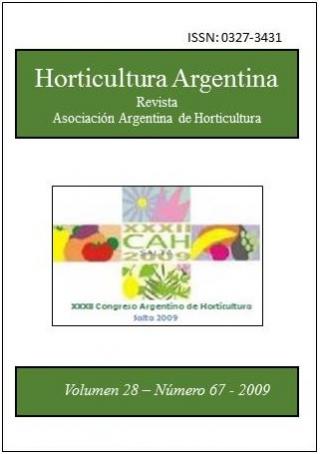Ver ítem
- xmlui.general.dspace_homeCentros Regionales y EEAsCentro Regional Buenos Aires NorteEEA San PedroArtículos científicosxmlui.ArtifactBrowser.ItemViewer.trail
- Inicio
- Centros Regionales y EEAs
- Centro Regional Buenos Aires Norte
- EEA San Pedro
- Artículos científicos
- Ver ítem
Efecto de distintas secuencias de tratamientos de biofumigación sobre parámetros fisicoquímicos y biológicos del suelo, el rendimiento y la salinidad de cultivos de tomate y lechuga bajo cubierta
Resumen
En los últimos años, investigadores de distintos países han concentrado esfuerzos en desarrollar técnicas no contaminantes de desinfección del suelo. El objetivo de este trabajo fue evaluar el efecto de distintas secuencias de solarización y/o biofumigación (BIO). Los tratamientos evaluados consistieron en la combinación de dos desinfecciones realizadas en la primavera 2003 y 2005. Estos fueron 1. Testigo/Testigo, 2. Solarización/Solarización, 3. BIO con
[ver mas...]
En los últimos años, investigadores de distintos países han concentrado esfuerzos en desarrollar técnicas no contaminantes de desinfección del suelo. El objetivo de este trabajo fue evaluar el efecto de distintas secuencias de solarización y/o biofumigación (BIO). Los tratamientos evaluados consistieron en la combinación de dos desinfecciones realizadas en la primavera 2003 y 2005. Estos fueron 1. Testigo/Testigo, 2. Solarización/Solarización, 3. BIO con Estiércol/BIO con Brócoli, 4. BIO con Colza/BIO con Brócoli. Se observó control de nematodos en los 10 primeros cm del suelo, en el muestreo realizado inmediatamente después de la biofumigación, realizada en noviembre de 2005. Las diferencias entre tratamientos y el testigo se mantuvieron para esta especie (P ≤ 5 %) hasta febrero del 2007. El porcentaje de colonias de Sclerotium rolfsii recuperadas de esclerocios fue siempre mayor en el testigo sin tratar, pero a 35 cm el efecto de los tratamientos fue menor. Fusarium solani fue encontrado solamente en el testigo a 10 cm de profundidad, pero en todos los tratamientos a 35 cm. En noviembre de 2006 se trasplantó un cultivo de tomate. El número de plantas muertas al final del ciclo fue significativamente mayor en el testigo sin tratar. Se obtuvieron diferencias altamente significativas entre tratamientos (P ≤ 1 %) para rendimiento y descarte total y descarte por pequeño y podredumbre apical. El testigo sin tratar mostró los menores rendimientos y mayores porcentajes de descartes. Después de la cosecha se observaron diferencias significativas para el número de agallas y porcentaje de raíces con síntomas de podredumbres en tomate. Los patógenos aislados de las raíces con síntomas de podredumbres fueron Pyrenochaeta lycopersici y Fusarium solani.
[Cerrar]
In the last years, researchers from different countries have made efforts to develop environmentally responsible soil disinfection techniques. The objective of this work was to evaluate the effect of different sequences of soil solarization and/or biofumigation (BIO). The treatments evaluated were the combination of two disinfections performed on spring 2003 and 2005. The sequences evaluated were: 1. Control/Control, 2. Solarization/Solarization, 3. BIO
[ver mas...]
In the last years, researchers from different countries have made efforts to develop environmentally responsible soil disinfection techniques. The objective of this work was to evaluate the effect of different sequences of soil solarization and/or biofumigation (BIO). The treatments evaluated were the combination of two disinfections performed on spring 2003 and 2005. The sequences evaluated were: 1. Control/Control, 2. Solarization/Solarization, 3. BIO with Chicken manure/BIO with Brocoli, 4. BIO with Brassica napus/BIO with Brocoli. Nematode control was observed at the first 10 cm of soil, inmediately after BIO treatments, performed at november 2005, differences (P ≤ 5 %) between treatments and control were observed for Nacobbus aberrans until february 2007. Percentage of Sclerotium rolfsii colonies obtained from sclerotia was always higher at control plots, but at 35 cm the treatment effect was lower. Fusarium solani was obtained only at control plots at 10 cm but in all treatments at 35 cm. In november 2006 a tomato crop was planted. The number of dead plants at the end of the cycle was significantly higher at control plots. Significant differences (P ≤ 1 %) between treatments were obtained for total yield, yield losses, and losses percentage due to small fruits and blossom end rot. Control plots showed lower yields and higher commercial yield losses. After harvest significant differences were observed for gall number and percentage of root rots caused by Pyrenochaeta lycopersici and Fusarium solani.
[Cerrar]

Fuente
Horticultura argentina 28 (67) : 5-17. (2009)
Fecha
2009
Editorial
Asociación Argentina de Horticultura
ISSN
1851-9342
Formato
pdf
Tipo de documento
artículo
Palabras Claves
Derechos de acceso
Abierto
 Excepto donde se diga explicitamente, este item se publica bajo la siguiente descripción: Creative Commons Attribution-NonCommercial-ShareAlike 2.5 Unported (CC BY-NC-SA 2.5)
Excepto donde se diga explicitamente, este item se publica bajo la siguiente descripción: Creative Commons Attribution-NonCommercial-ShareAlike 2.5 Unported (CC BY-NC-SA 2.5)


